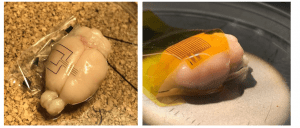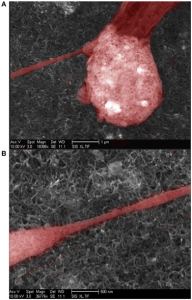Highlighted projects and research directions
Brain Machine Nano Neural Interfaces for Next Generation Implants
The evolution of the neural prosthesis as a clinical solution for treatment and management of neural disorders has been focused on three major challenges; reducing tissue damage, increasing stimulation/recording resolution and implant life. We focus on biology, chemistry and physics of the interface while exploring innovations in nanotechnology to address those challenges with a focus on developing high fidelity, stable and long term nanoneural interfaces. Students interested in these projects will work at the interface of engineering and medicine in a multidisciplinary environment and engage in labs at leading labs at AUB and the United states working in the field.
Applications of Ultrasound in Nervous System
Low frequency ultrasound is a promising modality for focused, non-invasive stimulation of the peripheral and central nervous system. We have several openings for students looking to work on the application of US in the brain.
Capturing and Characterizing Circulating Tumor Cells (CTCs) in Point-of Care-Platforms
CTCs carrying significant information of cancer progression and metastasis make their way from primary or metastatic lesions and enter into circulation. Isolating these from the bloodstream and the characterizing them is essential for early detection and monitoring of cancer. The efforts of my group will be focus on potentiometric and/or mechanical signature of CTCs for detection and nanostructured surfaces for capture.
Topics of interest
- Neural adhesion
- Cancer cells and diagnostics
- Nanomaterials
- Biology, chemistry and physics of neural interface.
- Smart Materials
- Ultrasound
- Neurological diseases
- Retinal Prosthesis

Inkjet printed flexible and biodegradable brain interfaces for Electrocorticography (EcoG) place on a rat brain.

(Top) Scanning Electron Microscope image of neuron growing over a Single Well Carbon Nanotubes (SWCNT) coated surface. (Bottom) Scanning electron microscope image of neural processes growing over a SWCNT coated surface.

(Left) high density cancer enumeration chip. (Right) close up on single sites with cancer cells adhering to the surface.